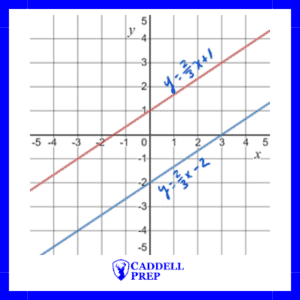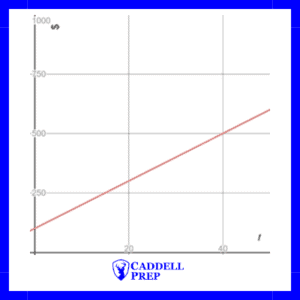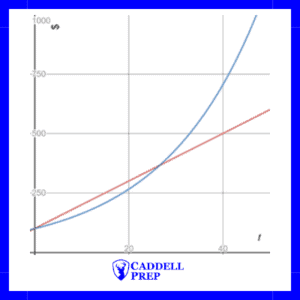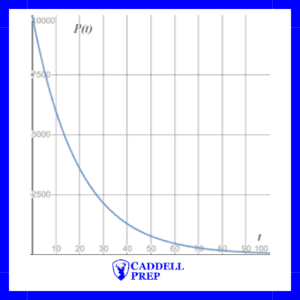Table of Contents
No Solution/Infinite Solutions
The SAT may ask questions regarding two functions that have no solution or infinite solutions.
No Solution to a System of Linear Functions
If you think of the two equations as functions, they would be two functions that never intersect.
If they are both linear equations, they will have the same slope but different y-intercepts.
For example, if we had the system of equations and
, we could graph them and see that they never intersect.

Here is an example of two linear equation that never intersect.
,
It isn’t easy to immediately notice, but both equations have the same slope. Solve for y in the second equation.
Divide both sides by 3 to get
Both functions have a slope of
Here is a graph of both functions.

Infinite Solutions to a System of Linear Functions
If you think of the two equations as functions, they would be graphed on top of each other.
If they are both linear equations, they will have the same slope and y-intercept.
For example, the following system of equations has infinite solutions.
,
Solve for y in both equations, and you’ll see that both equations are actually the same: .
If both functions were graphed, they would be graphed right on top of each other, so there would be infinite solutions.
Number of Solutions to Quadratic Equations
Example
How many solutions are there to the equation ?
A. 3
B. 2
C. 1
D. 0
Explanation & Solution
In this case, you can immediately eliminate choice A, because there can’t be 3 solutions if the greatest exponent is 2.
Since the greatest exponent is 2, we should get one side of the equation equal to zero then see if we can factor. If we can’t factor, use the quadratic formula.
We need to get one side equal to 0, so we can factor or use the quadratic equation.
Subtract 9x from both sides to get
Subtract 1 from both sides to get
We can’t factor, so we should use the quadratic equation.
,
,
Substitute those values into the quadratic equation.
,
,
,
,
We can stop here. We don’t have to find the exact solutions, just the number of real solutions.
There are two real solutions, they are:
and
The answer is B. 2
Percent
Students are expected to answer questions on the SAT that incorporate percent. Some questions will be word problems where a student has to find the percent change (percent increase or percent decrease), the new value after a percent increase, or identify an equation that can be used to find a new value after a percent change.
Fractions to Percentages
A percent represents the number you would expect out of 100.
If you are only correct 1 out of every 2 questions, then you would be correct 50 out of 100 times, or 50% of the time.
To change a fraction to a percent, you can create an equivalent fraction with a denominator of 100. The numerator is the percent.
,
,
Decimals to Percentages
To change a decimal to a percent, use the fact that means
hundredths, which can be written as
,
and .
More simply, to change from a decimal to a percent, move the decimal 2 places right.
,
,
Percent Formula
For example, what is 30% of 60?”
Substitute the values into the equation.
The part is typically associated with “is” in the sentence, and the whole is typically associated with “of” in the sentence.
Cross-multiply to get
Divide by sides by 100
Solve by Writing an Equation
In math “of” means multiply and “is” means “equals”.
We can look at the same question and write an equation.
What is 30% of 60
,
Tax. Mark-up, & Discount (Increase and Decrease)
Increase by a Percent (Including Tax and Mark-Up)
Tax and mark-up increase the cost of a purchase.
For example, if a pair of shoes is $80 and there is 8% tax, we would have to add the tax on to the total cost.
We would have to calculate the tax and then add it on to the original cost.
8% of $80 is found by multiplying $80 and 0.08.
Now, we have to add the tax on to the price of the shoes,
Solving for the new value in a percent increase in one step (useful algebraic questions)
Another way to look at it is that 100% of the price of the shoes is $80.
If it increases by 8% because of tax, the cost is now 108% of $80.
We can solve for the new total after tax in one step
.
The same concept applies to all increases.
If something increases by 40%, it will be 140% of what it previously was.
If something increases by 7.5%, it will be 107.5% of what it previously was.
If something increases by 100%, it will be 200% of what it previously was.
Decrease by a Percent (Including Discount)
Discount decreases the cost of a purchase.
For example, if a pair of shoes is $80 and there is 30% discount, we would have to subtract the discount from the total cost.
We have to calculate the discount and subtract it from the original cost.
30% of $80 is found by multiplying $80 and 0.30.
.
Now, we have to subtract the discount from the original cost.
.
Solving for the new value after a percent decrease in one step (useful for algebraic questions)
Another way to look at it is that 100% of the price of the shoes is $80.
If it decreases by 30% because of tax, the cost is now 70% of $80.
We can solve for the new price after the discount in one step
.
The same concept applies to all decreases.
If something decreases by 40%, it will be 60% of what it previously was.
If something decreases by 7.5%, it will be 92.5% of what it previously was.
If something decreases by 24%, it will be 76% of what it previously was.
Equations that Incorporate Percents
On the SAT, you may be asked to identify equations that can be used to solve for a variable. In other words, sometimes you don’t have to solve for a missing value, you just need to choose the equations that can be used to solve for the missing value.
First, let’s review some expressions.
If a book costs $x and there is 5% tax, the total cost would be $1.05x because we have to increase the cost by 5%.
If a book costs $x and there is 15% discount, the total cost would be $.85x because we have to decrease the cost by 15%, which would leave us with 85% of the cost.
If a book costs $x, but there is a 15% discount and 5% tax, the total cost would be $1.05(.85x).
Percent Change
The formula for percent change, whether increase or decrease, can be found with a simple equation.
Percent Change
For example, if a stock increased from $80 to $100, the change is $20 and the original value was $80. Let’s use the formula to find the percent change.
Percent Change
Percent Change
If the stock decreased from $100 to $80, the change is still $20, but this time the original value is $100. Let’s use the formula to find the percent change in this scenario.
Percent Change
Percent Change
Growth and Decay
To have a strong understanding of growth and decay for the SAT, you need knowledge of percentages first.
If you haven’t gone through the information on percent, I suggest you go back and review that first.
Exponential Growth


Here is a comparison of the two. As you can see from the graph, exponential growth results in a graph that is curved upward.

The function is based on an initial value of $100 that increases by 5% each year. It is based on the general formula:
where is the value,
is the initial value (in this case $100),
is the rate (in this case .05 for 5%), and
is time (in this case in years)
Since we add the rate to 1, we end up with growth.
Exponential Decay

The function is based on an initial value of 10,000 that decreases by 5% each year. It is based on the general formula:
where is the value,
is the initial value (in this case 10,000),
is the rate (in this case .05 for 5%), and
is time (in this case in years)
Since we subtract the rate from 1, we end up with decay.
Exponents
Lorem ipsum dolor sit amet, consectetur adipiscing elit. Ut elit tellus, luctus nec ullamcorper mattis, pulvinar dapibus leo.
Multiplying Terms with Exponents
When you multiply terms that have the same base, you add exponents.
Here is a more complicated one
If there is no exponent written, there is an exponent of 1.
Dividing Terms with Exponents
When you divide terms that have the same base, you subtract exponents.
x^8/x^3 =x^5
Here is a more complicated one
The y^3 terms in the numerator and denominator cancel out. The other exponents subtract.
Raising an Expression with an Exponent to an Exponent
When you raise an expression with exponents to another power, you multiply the exponents.
Example
Simplify the expression below.
becomes
Exponent of Zero
Any number raised to zero is 1.
Also
There are a lot of terms, but the entire expression is raised to 0, so it is equal to 1.
Be careful.
In this example, only the is raised to 0, so
becomes 1. The
remains
.
Negative Exponents
Think of a negative exponent as a sign that the term is in the wrong spot. If it is in the numerator, move it to the denominator and make the exponent positive. If it is in the denominator, move it to the numerator and make it negative.
For example
In the example above, the exponent for the a is negative, so move it to the numerator.
Here is another example
Only the has a negative exponent, so only the
should move to the denominator with its exponent. Do not move the coefficient, 2.
Moving the 2 along with the is a common mistake.
We would end up with
Fractions as Exponents
A fraction in the exponent represents a root, such as a square root or cubed root.
,
,
The denominator of the exponent represents the root.
It is possible for the numerator to be a number other than 1. Treat the numerator like a regular exponent.
The 4 in the numerator means to the 4th power. The 3 in the denominator means cubed root.
Example
Rewrite with an integer power and root.
Explanation & Solution
5 is the power, and 2 is the root
Imaginary Numbers
Lorem ipsum dolor sit amet, consectetur adipiscing elit. Ut elit tellus, luctus nec ullamcorper mattis, pulvinar dapibus leo.
Imaginary Number, i
does not result in a real number. There is no real number that when multiplied by itself will result in
.
is imaginary. We represent this imaginary number with the letter
.
Combining Like Terms
When combining like terms, treat as if it’s a variable.
For example, and
are not like terms but
and –
are, just like
and
are not like terms, but
and
are.
When combining like terms, just add the coefficients.
A simplified expression is typically in form, where the number is written first followed by the
-term.
Example
Simplify .
Explanation & Solution
Here we will combine like terms by adding the like terms together.
and
are like terms, so we can add them together to get
.
and
are like terms, so we can add them together to get
.
We end up with , which is in
form. In this case,
is
and
is
.
Multiplying and Simplifying Complex Expressions
Since , then
.
When we multiply terms or expressions that have , we may end up with terms that have
.
It’s important to remember that is simply
.
Example
Simplify .
Explanation & Solution
To simplify this, we will have to distribute twice (FOIL).
,
,
,
So we would end up with
We an combine the like terms,
and
, to get
Remember that is really
, so we have
,
Now, we can combine like terms to get
.
Rationalizing the Denominator When the Denominator has an i-term
Occasionally on the SAT, you may see a question that requires rationalizing the denominator.
In this case, the denominator has an expression including .
To rationalize the following, we would simply multiply the number and denominator by .
,
,
,
Remember that is
,
,
We typically wouldn’t write a negative number in the denominator, so we should negate the numerator and denominator.
Our final answer is
,
If we have to write it in form, we would divide both terms in the numerator by the denominator to get
And write the -term second


